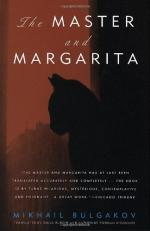|
This section contains 10,416 words (approx. 35 pages at 300 words per page) |

|
SOURCE: Arenberg, Carol. “Mythic and Daimonic Paradigms in Bulgakov's Master i Margarita.” Essays in Literature IX, no. 1 (spring 1982): 107-25.
In the following essay, Arenberg examines Bulgakov's views of history and the artist, and considers the ways in which these views led to the thematic structure of The Master and Margarita.
The underlying thematic structure of Bulgakov's Master i Margarita (1940) has proved to be elusive, for it contains elements that seem to contradict every theory. Since 1966-67, when Soviet Authorities allowed the novel to be published (and it was immediately acclaimed a literary masterpiece), it has produced a spate of literary analyses and explorations from various points of view, ranging from Proffer's early study of the novel as a form of Manippean satire1 to Lesley Milne's monograph examining the similarities between the structure of the novel and the Medieval carnival.2 These studies have shed valuable light on certain aspects...
|
This section contains 10,416 words (approx. 35 pages at 300 words per page) |

|


